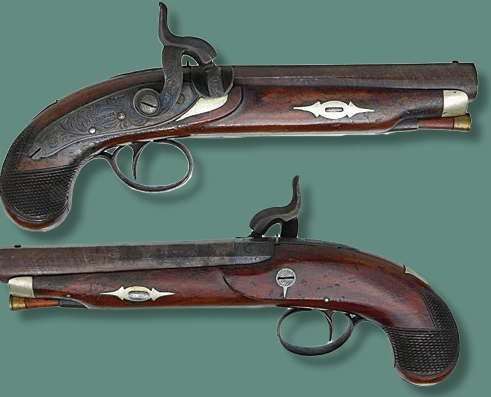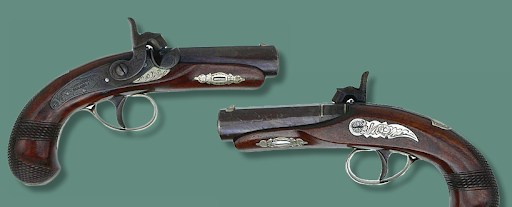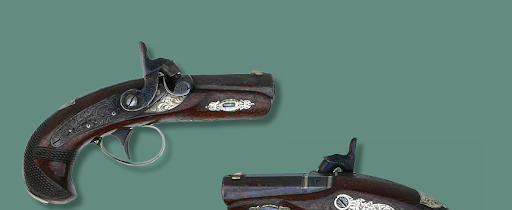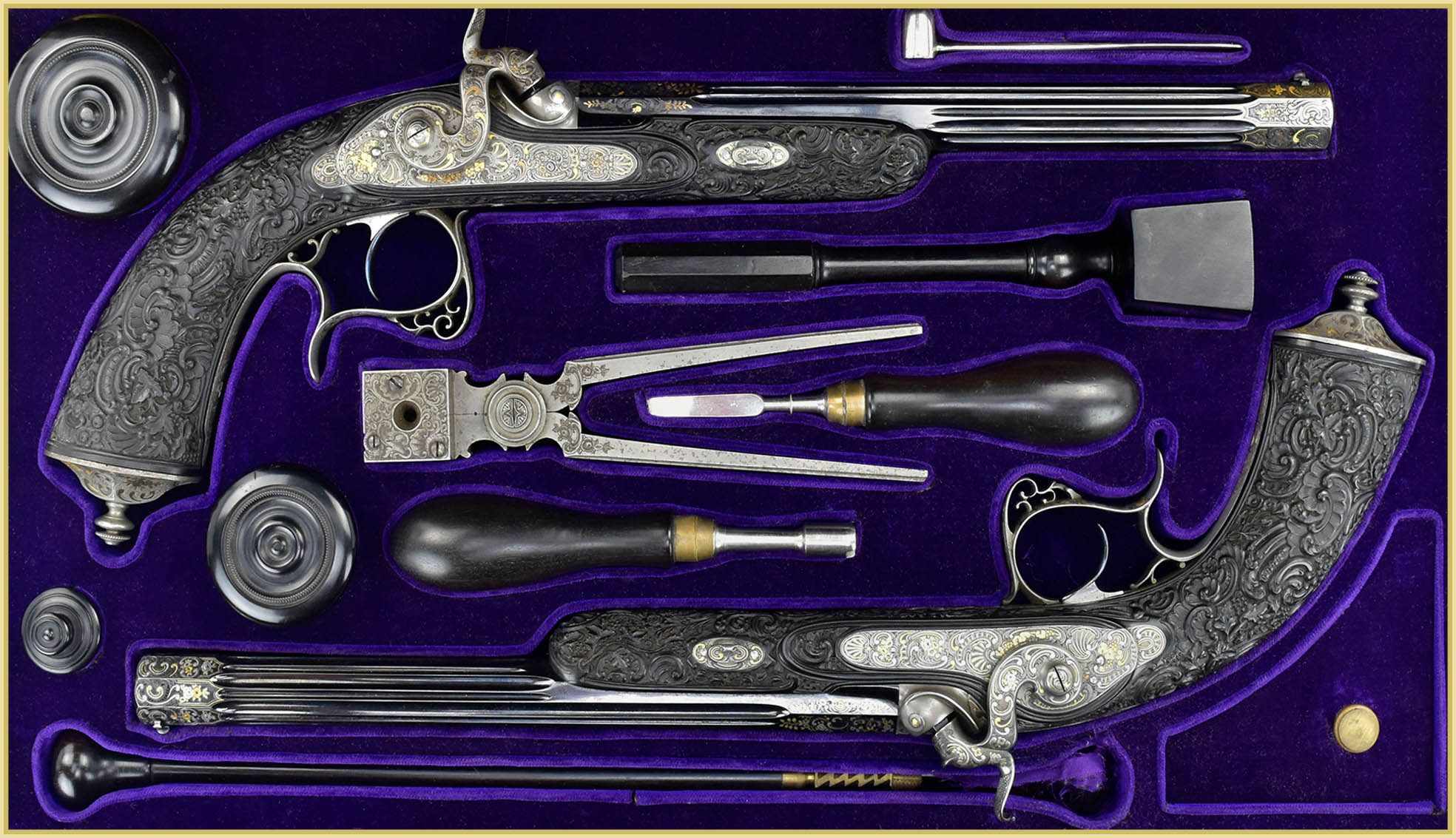Henry Deringer Pocket Pistols
Most people have heard of the Deringer (or Derringer) pistol because John Wilkes Booth used one in the infamous assassination of Abraham Lincoln in 1865. To gun collectors today, Henry Deringer, Jr. of Philadelphia, Pennsylvania (1786- 1868) refined the small personal protection pistols, and whose last name is now the generic term for many small percussion and cartridge pistols known to gun collectors from the early 1800s forward. One continually hears stories of gunfighters, gamblers, sailors, and just common people relying on them for protection purposes. The writer heard of a Deringer pocket pistol that was found in an antique shop on the Island of Malta a few years ago – very likely carried there by an American sailor in times past.
A general description of a Henry Deringer Pocket Pistol would be that of a single-shot percussion pistol having an iron barrel from 15/16” upwards to 6” in length in calibers from .38 to .50 or more. Most calibers are in the mid-40s and are always rifled, which, in the very short barrel lengths, seems useless except perhaps for marketing purposes. (The writer has fired one with a 2” barrel, and it was surprisingly accurate for a pistol with such a short barrel.) The pistols with longer barrels will usually have ramrods. The stocks are almost always of straight-grained walnut, but some were of a deluxe or burl grain. A few stocks are known to be made of brass or ivory, but these are especially rare. Furniture is generally German silver, but silver and gold are also known and could be furnished as “extras”. Early pistols had fittings of iron. The furniture of all types was almost always engraved. Barrels were usually browned with gold colored striping, which was actually a copper oxide treatment that Deringer apparently thought would simulate a Damascus twist.

The gold-colored striping was very thin and easily worn off. It is very unusual to see it still existing in examples today. Lockplates and breech plugs were usually case hardened. The iron parts were lacquered over when the guns were finished. Many extra features were offered including cap boxes in the butts, silver and gold bands and inlays and fancier walnut stocks. There are a few that have the iron parts silver-plated. Most, if not all, pistols produced were made up as pairs. Most were sold at Henry Deringer’s shop in Philadelphia; however, he did rely on agents from all over the United States to market them, and many times those pistols were marked with those agents’ names and addresses. There were also a few larger holster-sized pistols made, as well as several dueling sets.
According to court records of a statement in a patent infringement case brought by Henry Deringer, approximately 5,300 pairs of pistols were made between the mid-1820s and the mid-1850s. As the popularity of this pistol grew, many other makers attempted to cash in on this popularity by making similar pistols, violating Deringer’s patent. Many were almost identical to the authentic Deringer, and some were a little different, but Henry Deringer had to continually fight to protect his patent. He attempted to “proof” his guns with a “P” at the breech to show that they were authentic Deringer pistols, but even that marking was fraudulently applied to some of these infringements. Production was reduced from the mid-1850s on until after the Civil War, when production ceased altogether.
This article will picture and describe a few select Derringer pocket pistols that will illustrate the different barrel lengths from the shortest and most desirable at 15/16” to 4-3/8”. There will be instances of German silver, silver and gold mountings and inlays as well as fancy grade stocks, cap boxes in the butts and so on. The pistols shown will range in dates of manufacture from the early 1830s to the early 1860s.
This very early larger pocket pistol had a barrel length of 4-3/8” in .45 caliber with an overall length of 8-3/4”. Its pistol is mounted in iron and German silver. Most of the brown finish is left on the barrel. It never had the applied copper oxide, but it has a look of Damascus steel that is so good that the barrel appears as if it could have really been made that way. There are no bands at the breech, and there is no “P” at the breech because this pistol was made before most of the infringement lawsuits began. About all of the original case hardening is on the lock plate and the breech plug. There is only a German silver inlay in the butt, around the barrel wedge and behind the barrel tang. This pistol has a ramrod. This size, even with its extra-long barrel, can still be considered a pocket pistol. With the early iron mounts and the shielded nipple bolster, this early pistol dates from 1830 to 1835.
This larger pistol has a barrel length of 2-3/4” in .46 caliber with an overall length of 8”. This pistol is mounted in German silver. Most of the brown finish is left on the barrel with just a little of the copper oxide striping. This pistol has the “P” proof with borders around it. Bands at the breach are German silver. There is a cap box in the butt and this pistol also has a ramrod. This size is about the largest that can still be considered a pocket pistol. With the early shielded nipple bolster, this pistol dates from 1845 to 1850.

This larger pistol has a barrel length of 2-3/8” in .38 caliber with an overall length of 7-1/8”. This pistol is mounted in silver and German silver. Most of the brown finish is left on the barrel with just a little of the copper oxide striping. This pistol has the “P” proof with borders around it. The inlaid bands at the breech are gold. There is a cap box in the butt and this pistol also has a ramrod. This size is about the smallest seen where a ramrod is present. The stock is burl-grained walnut, an extra at the time. Engraved with the name of its original owner: “R. F. Morrow”. It was probably made in the early 1850s.

This pistol has a barrel length of 2-1/2” in .50 caliber with an overall length of 7”. It is mounted in German silver. Most of the brown finish is left on the barrel with just a little of the copper oxide striping. This pistol has the “P” proof with borders around it. Bands at the breach are German silver. Much of the case hardening remains, and the stock shows most of its original finish. This is somewhat unusual as it is fitted with a “peanut-sized” lock plate on a pistol that would normally have a larger lock. It was probably made in the mid-1850s.

This very fine pistol has a barrel length of 1-3/4” in .36 caliber with an overall length of 6”. This pistol is mounted in German silver. All of the brown finish is left on the barrel, with most of the gold colored striping. This pistol has the “P” proof with borders around it. Bands at the breach are German silver. All of the case hardening also remains, along with most of the original lacquering still present. This pistol has a cap box in the butt. It was probably made between 1850 and 1855.

Considered by some as “Peanut” size, this pistol has a barrel length of 1-1/2” and an overall length of 5-3/8”. The caliber is .46, considered rather large for this size of pistol. It is mounted in German silver. This pistol has the “P” proof on the breech without the bordering that usually surrounds this mark. Bands at the breach are German silver. Most of the brown finish is left on the barrel with just a hint of the copper oxide striping. It was probably made between 1850 and 1855.

This is the smallest and rarest “Peanut” size with the shortest barrel length offered by Deringer at 15/16” with an overall length of 4-1/4”. The barrel is rifled for its short length and is of .38 caliber. It has a browned finish without evidence that it was ever treated with the gold colored striping. This pistol is mounted in German silver. This pistol has the “P” proof on the breech without the bordering that usually surrounds this mark. It was probably made between 1855 and 1860. There are less than 10 examples of this smallest variation known.
Henry Deringer is recognized as the innovator of the small pistol that inspired a completely new type of small firearm that evolved from that of a single-shot percussion pistol made by many gunmakers (in addition to Henry Deringer) to small one, two, three, four, or even five-shot cartridge guns. Even some small revolvers are called “Derringers” today.

